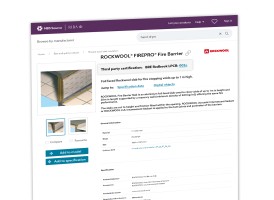
Third-party certification with NBS Source
15 May 2020
Over recent years, one of the most popular requests for improvements from construction profession...
31 March 2017 | By Richard Waterhouse
We are pleased to release the findings of our Specification Survey for Manufacturers. The findings of this survey are an invaluable resource for understanding the specification process, the needs of specifiers, and what they need from manufacturers to help them realise design intent.

Over the last few years, with the recent implementation of the BIM mandate, we are seeing the start of a transformation of the design and construction process. The temptation is to focus on the technology. Indeed, the technology allows us either to do what we were doing but better, or to do entirely new things.
But the technology is significant in another way. It supports the relationships that the design and construction process depends on. With those relationships, it enables deep, well-structured and well-described collaboration. This collaboration can only take place within a standardised, information-rich environment.
That information-rich environment is now at the heart of best design practice and includes BIM objects, BIM models, practice knowledge and external information such as standards and building regulations.
It also includes specifications. Specifications are integral here. They alone provide the level of information required to fully express design intent. For the specifier, collaboration involves close working with many parties, including the client, contractors and, just as importantly, construction product manufacturers. Effective collaboration requires shared understanding. In turn, shared understanding relies on a clear, unambiguous description of the shared goal; that which is to be built: the specification. Specifiers continue to value their relationships with manufacturers.
Specifiers continue to rely on manufacturers providing the right information, in the right structure and form, and at the right level, for any given stage of a project. Underlying this is the importance of a relationship of trust, and an understanding of shared aims.
“Specifications alone provide the level of information required to fully express design intent.”
The potential for innovative design relies on the continued delivery of innovative construction products. Working with the specifier allows the right product choice. This choice is supported by detailed product performance information, and helps the defence of a specification. The erosion of a specification is as much an issue for specifiers as it is for manufacturers.
At NBS, we have been helping construction product manufactures work with specification writers for over 40 years. We produce a range of tools to bring rich, up-to-date and standardised information to the specification writer. Central to this is construction product information. NBS Plus brings a wealth of detailed construction product information to the specification writer just when it is needed.
However, at NBS we are also aware of, and leading on, the radical changes that we are seeing within construction information. NBS Create is the world’s first BIM-ready specification writing environment. The NBS BIM toolkit is a free-to-use tool that allows the designer to set out who is responsible for what and when within a project, and to describe the level of detail and level of information that’s needed at each stage of the RIBA Plan of Work. Through our ‘plug-ins’ to all leading BIM creation tools, the specifier can rapidly check for inconsistencies between a model and a specification, so making sure that product choices are embedded in both information sources.
The NBS National BIM Library allows the specifier to drop generic and proprietary BIM objects into the BIM, knowing that those models conform to the NBS BIM object standard. One downloaded BIM object can be used multiple times in one project, as well as across multiple projects. What’s significant here is not just the available range of tools, but their interoperability. Throughout the NBS design information ecosystem, we have enabled the designer ready access to well-formed informed construction product information. So the specifier can ensure consistency and accuracy across a range of information sources. This is needed to provide the framework for effective collaboration.
We hope this report helps understanding of current specification practice and the importance of construction product information to it. The report also shows the direction of specification in our increasingly information-rich industry.